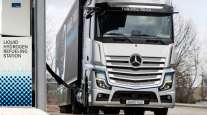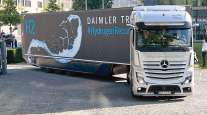Detroit Reman Taps New Chief, Announces Expansion of Plant
This story appears in the Aug. 19 print edition of Transport Topics.
HIBBING, Minn. — Detroit Diesel Remanufacturing unveiled plans for expansion of its electronics unit here and announced a change in top management of this Daimler Trucks North America subsidiary.
The company broke ground on a 60,000-square-foot office and plant complex Aug. 14 that eventually will house the work now being done in four leased buildings scattered throughout the city.
On the same day, Daimler said Sanjiv Khurana will succeed Stefan Kurschner as president of the remanufacturing business, effective Sept. 1.
Since 2008, Khurana has been chief financial officer of Daimler’s commercial vehicles business in Chennai, India. He started with Daimler in 1999 in Portland, Ore., where DTNA is based.
Kurschner has been president of Detroit Diesel Remanufacturing for the past four years. He will become president of Daimler Commercial Vehicles of Mexico.
Detroit Diesel Remanufacturing (aka Detroit Reman) supplies the trucking aftermarket with remanufactured components and systems.
In addition to its Detroit headquarters, it has five U.S. facilities and one in Mexico with a combined 1,400 employees.
“Remanufacturing is not just about iron,” Kurschner said during an Aug. 14 press event. He added that remanufacturing is a valuable process because “we’re not just bringing parts back to their original standards, we improve on them when we can.”
The Hibbing facility’s 100 full-time and 20 part-time employees work on engine control modules, dashboard instrument clusters, mechanical valves and wiring harnesses.
The remanufacturing of components often deals with heavy pieces of steel or aluminum that need to be cleaned off, straightened out and polished up, but at Detroit Reman the job is being done on delicate electronic components.
Detroit Reman said operations in the new facility could lead to the creation of 30 to 50 new jobs within three to five years.
The company’s main product line is engine control modules, the electronic brain of the modern diesel engine. The company made its first-generation ECM in 1985 for use in its Series 60 truck engines. Seven more generations have followed.
Series 60 was replaced by Daimler’s DD series of engines in 2007, but many of the 60s are still on the road and sometimes need new ECMs. The plant either can manufacture a new ECM or remanufacture an old version that’s been traded in — known as a “core” in remanufacturing circles.
The ECMs are the size of a large book, and plant employees make about 85 a day.
Kurschner said the work on ECMs could be transferred to other products such as circuit boards for advanced medical equipment.
The work on circuit boards is painstaking, and what lightning can do to a tree, static electricity can do to a circuit board, said Carl Olson, the plant’s quality manager. To protect the ECMs, employees wear smocks designed to dampen the body’s natural static field. Their shoes have heel straps to ground charges to a floor made of material that increases the absorption of static.
Technicians doing soldering work — often with the assistance of a microscope — must be tethered to a wrist strap that neutralizes charges.
Mechanical valves controlled electronically, or mechatronics, are examples of how a remanufactured part can be better than the original version.
Exhaust gas recirculation valves and variable-pressure output devices were breaking early and coming into the plant for remanufacturing. Engineers here examined the parts to see which segments failed and why.
They designed more durable versions of the parts and reported their findings to the original manufacturers, who updated their processes for producing new components, thereby reducing warranty claims.
“We can sometimes add functionality and make a part better than its original design,” Engineering Manager Wade Thorson said.
On the manufacturing side, plant employees make small volumes of highly complex wiring harnesses. There are designs for 200 types of harnesses on file, and total annual production ranges from 1,500 to 5,000 harnesses.
In contrast, the Detroit Reman facility in Toluca, Mexico, handles high volumes of simpler harnesses.
Harness length runs from 11 inches to 60 feet, and they can be made for emergency or mining vehicles in addition to trucks.
While 90% of the work here is done for Daimler vehicles — which include trucks, buses and Mercedes-Benz automobiles — the plant also has outside customers.
A recent customer was the Niagara Frontier Transportation Authority in Buffalo, N.Y. Its light-rail vehicles needed a midlife upgrade, so NFTA asked Detroit Reman to improve the trains’ propulsion logic modules. In addition to cleaning and repairing the circuit boards, Detroit Reman wrote new software to improve vehicle operations.




